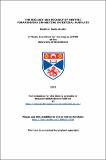Files in this item
The biology and ecology of benthic foraminifera inhabiting intertidal mudflats
Item metadata
| dc.contributor.advisor | Paterson, D. M. (David M.) | |
| dc.contributor.author | Austin, Heather Anne | |
| dc.coverage.spatial | 234 p. | en_US |
| dc.date.accessioned | 2015-08-03T09:32:17Z | |
| dc.date.available | 2015-08-03T09:32:17Z | |
| dc.date.issued | 2003 | |
| dc.identifier | uk.bl.ethos.637479 | |
| dc.identifier.uri | https://hdl.handle.net/10023/7099 | |
| dc.description.abstract | Benthic foraminifera inhabiting the mudflats of the Eden Estuary, NE Scotland, exhibited a single annual peak in abundance at both high (270 individuals 10 cm⁻²) and low shore (210 individuals 10 cm⁻²) intertidal sampling stations during June 2000. The increased total abundance coincided with reproduction in the two dominant foraminiferal species Elphidium williamsoni (May) and Haynesina germanica (June) at both sites. Benthic diatom biomass, measured as chlorophyll c, peaked at the high intertidal site during March and April 2001 (36 and 37 mg m⁻², respectively) and at the low intertidal site in June 2000 (45 mg m⁻²). The high intertidal foraminiferal populations appeared to display a lagged response to increases in chlorophyll c. Multivariate statistics suggest that abiotic factors control the abundance of foraminifera at the high intertidal site. At the low intertidal site, total foraminiferal abundance demonstrated an almost immediate response to increased chlorophyll c and multivariate statistics suggested biotic factors are more important in controlling foraminiferal species abundance here. Ingestion rates of ¹³C-labelled benthic diatoms over a five-day experimental period were high (e.g. enrichment values for Elphidium were recorded as 687 ± 121 % after 1 day) in intertidal benthic foraminifera. Laboratory observations of E. williamsoni demonstrated rapid asexual reproduction (within 3 days) and growth rates of up to 14 µm day⁻¹ were estimated. Three benthic foraminiferal species E. williamsoni, H. germanica and E. oceanensis ingest motile benthic diatoms as a food resource on the intertidal mudflats of the Eden Estuary. Novel application of natural abundance stable isotope (δ¹³C and δ¹⁵N) techniques demonstrated the trophic position of intertidal benthic foraminifera, confirming that they largely ingest and assimilate organic matter derived from benthic diatoms. Foraminifera have largely been overlooked in meiofaunal studies, but play a significant role in the rapid transfer of autotrophic carbon to higher trophic levels within benthic marine food webs. | en_US |
| dc.language.iso | en | en_US |
| dc.publisher | University of St Andrews | |
| dc.subject.lcc | QL368.F6A8 | |
| dc.subject.lcsh | Foraminifera--Scotland--Eden River Estuary | en_US |
| dc.subject.lcsh | Benthos--Scotland--Eden River Estuary | en_US |
| dc.title | The biology and ecology of benthic foraminifera inhabiting intertidal mudflats | en_US |
| dc.type | Thesis | en_US |
| dc.type.qualificationlevel | Doctoral | en_US |
| dc.type.qualificationname | PhD Doctor of Philosophy | en_US |
| dc.publisher.institution | The University of St Andrews | en_US |
This item appears in the following Collection(s)
Items in the St Andrews Research Repository are protected by copyright, with all rights reserved, unless otherwise indicated.

